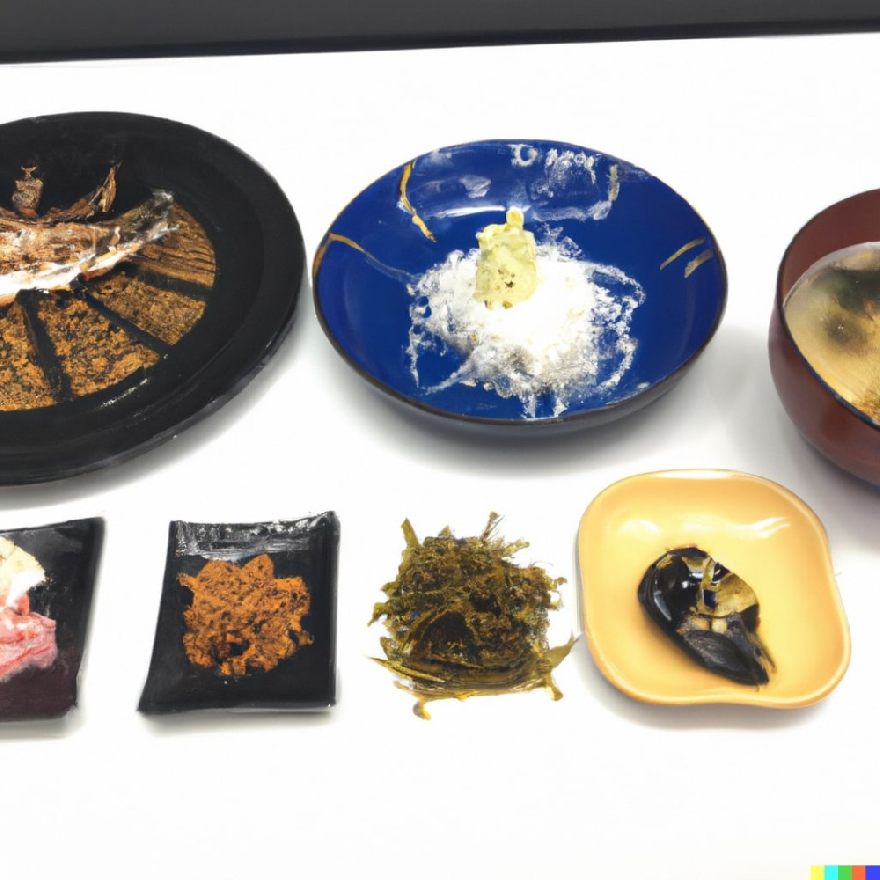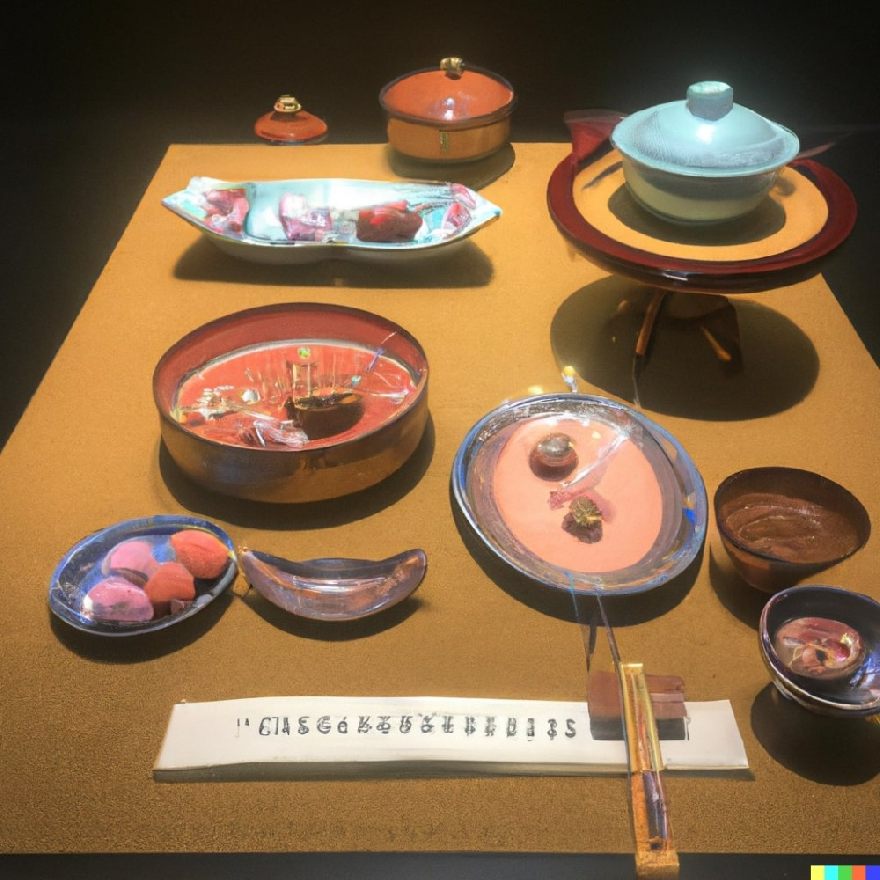Japanese Food History from 10.000 BC till now.
The history of Japanese food is a long and fascinating one, with influences from various cultures and periods in history. Here is a brief overview of the evolution of Japanese food from the prehistoric period to the present day:
10,000 BC: The Jomon period (named after the characteristic cord-marked pottery found from this time) is considered the earliest period of Japanese history, and it is believed that the people of this time relied on hunting, fishing, and gathering for their food. They also cultivated wild plants and developed techniques for preserving food, such as drying and fermenting.
300 BC to 300 AD: The Yayoi period saw the introduction of rice cultivation to Japan, which quickly became a staple food. This period also saw the development of metal tools, which allowed for the production of ceramics and the development of more sophisticated cooking techniques.
794 to 1185: The Heian period was a time of cultural flourishing in Japan, and food played a significant role in this. The court aristocracy of this period developed a sophisticated cuisine that was influenced by Chinese and Korean food, as well as local ingredients and traditions. This period is also when the first written records of Japanese food were recorded, in the form of poetry and literature.
Advertising1192 to 1333: The Kamakura period saw the rise of the samurai class, who developed their own food culture based on the principles of Zen Buddhism. This included a focus on simplicity, natural flavors, and the use of local ingredients.
1333 to 1573: The Muromachi period was a time of political upheaval and social change in Japan, and this is reflected in the food culture of the time. The cuisine of this period was characterized by the use of various ingredients and techniques from around the world, as well as the development of new cooking styles such as tempura (deep-fried food).
1573 to 1868: The Edo period was a time of relative stability and prosperity in Japan, and this is reflected in the food culture of the time. The cuisine of this period was characterized by the development of various regional cuisines, as well as the rise of street food and the development of the first modern restaurants.
1868 to present: The Meiji period saw the opening up of Japan to the rest of the world, and this had a significant impact on the food culture of the country. Western ingredients and cooking techniques were introduced, and the food industry began to modernize. Today, Japanese food is known for its diverse and sophisticated cuisine, which is influenced by a wide range of ingredients and cooking styles from around the world.
Advertising

Japanese Food traditions changed when the Americans and British arrived.
The arrival of the Americans and British in Japan had a significant impact on the country's food culture. During the Meiji period (1868-1912), Japan underwent a process of modernization and westernization, and this included the introduction of many Western ingredients and cooking techniques. The first American and British consulates in Japan were established in the 1850s, and with them came a influx of Westerners who introduced new foods and cooking methods to the country.
One of the most significant changes that occurred during this time was the introduction of wheat flour, which was used to make bread, cakes, and other baked goods. This was a significant departure from the traditional Japanese diet, which had been based primarily on rice, vegetables, and seafood. Other Western ingredients that were introduced during this period included butter, milk, cheese, and beef, which had not been widely available in Japan before.
In addition to introducing new ingredients, the Americans and British also introduced new cooking techniques, such as grilling and roasting, which became popular in Japan. These changes had a major impact on the food culture of the country, and they continue to be evident in the modern Japanese cuisine that we know today.

Today the modern Fast Food era arrived in Japan.
The fast food industry has had a significant presence in Japan in recent decades. The first fast food chain to arrive in Japan was McDonald's, which opened its first restaurant in Tokyo in 1971. Since then, many other fast food chains have entered the Japanese market, including KFC, Burger King, and Pizza Hut.
In Japan, fast food restaurants have adapted to local tastes and preferences by offering a range of menu items that are specific to the Japanese market. For example, McDonald's in Japan offers teriyaki burgers, shrimp burgers, and rice bowls in addition to its more traditional menu items. Other fast food chains have also developed menu items that are specific to the Japanese market, such as KFC's "Karaage-kun," a fried chicken snack, and Pizza Hut's "shrimp and mayonnaise" pizza.
Despite the growing popularity of fast food in Japan, the country also has a long tradition of street food, which has remained an important part of the food culture. In addition, Japan has a thriving restaurant scene that offers a wide range of cuisines, including traditional Japanese, Western, and fusion.

Streetfood Traditions in Tokyo and Osaka.
Street food, or "yatai," has a long and rich tradition in Japan, and it can be found in many cities throughout the country, including Tokyo and Osaka. In Tokyo, street food can be found at various outdoor markets, such as the Tsukiji Fish Market and the Ameyoko Market, as well as at festivals and events. Some popular street food items in Tokyo include takoyaki (octopus balls), yakiniku (grilled meat), and okonomiyaki (a savory pancake made with a variety of ingredients).
In Osaka, street food is an integral part of the city's food culture, and it can be found at various outdoor markets, such as the Dotonbori and Kuromon markets, as well as at festivals and events. Some popular street food items in Osaka include takoyaki (octopus balls), kushiage (deep-fried skewers), and okonomiyaki (a savory pancake made with a variety of ingredients).
In recent years, street food in Japan has undergone something of a revival, with the emergence of new, innovative street food vendors offering a wide range of cuisines and flavors. Many of these street food vendors are located in bustling, urban areas, and they are popular with both locals and tourists. Street food in Japan is an affordable and convenient way to try a variety of different dishes and flavors, and it is an integral part of the country's food culture.
Japanese Food is healthy.
Japanese food is often considered to be healthy due to the emphasis on fresh ingredients and the use of a variety of vegetables, seafood, and grains in the diet. Traditional Japanese meals are based on the principle of "ichiju issai," which means "one soup, one side," and this encourages the consumption of a balance of different foods.
Japanese cuisine also has a strong tradition of fermentation, which is believed to have health benefits. Fermented foods such as miso, natto, and sake are a common part of the Japanese diet, and they are rich in probiotics, which are beneficial for the digestive system.
Additionally, Japanese food is generally low in fat and calories compared to some Western cuisines, and it is often prepared using healthier cooking methods such as grilling, boiling, and steaming.
It's worth noting, however, that like any cuisine, Japanese food can vary in terms of its nutritional content depending on the specific ingredients and cooking methods used. Some Japanese dishes, such as tempura and tonkatsu, are deep-fried and may be high in calories and fat, while others, such as sushi and sashimi, are lower in calories and fat. Overall, however, Japanese food is generally considered to be a healthy and balanced diet.
Japanese Food plays a key role in the longevity industry.
Japanese food and lifestyle practices have long been associated with longevity and good health. Japan has one of the highest life expectancy rates in the world, and this is often attributed to the country's healthy diet and lifestyle.
Japanese cuisine is based on the principle of "ichiju issai," which means "one soup, one side," and this encourages the consumption of a balance of different foods. Traditional Japanese meals consist of a bowl of rice, a bowl of miso soup, and a variety of small side dishes, or "okazu," which can include grilled fish, pickled vegetables, tofu, and other plant-based dishes. This balanced approach to eating is believed to contribute to good health and longevity.
Japanese food is also generally low in calories and fat, and it is rich in nutrients such as protein, fiber, and vitamins. The Japanese diet is also high in seafood, which is a good source of omega-3 fatty acids, and it includes a variety of fermented foods, such as miso and natto, which are rich in probiotics and are believed to have health benefits.
In addition to diet, other lifestyle practices in Japan, such as regular physical activity and stress management, are also believed to contribute to the country's high life expectancy. Overall, Japanese food and lifestyle practices are considered to be an important part of the country's longevity industry.














